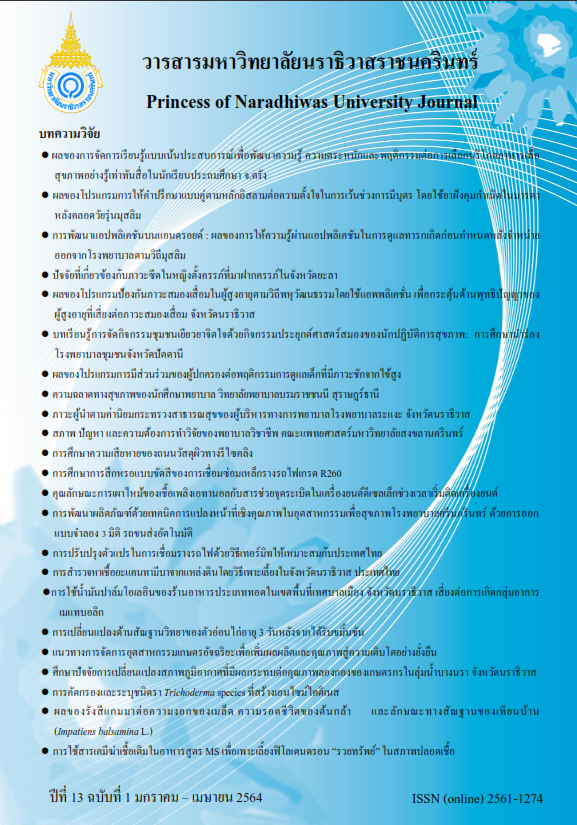Screening and Identification of Chitinase-Producing Trichoderma species
Keywords:
Trichoderma species, Chitinase, DNS methodAbstract
Most of the antagonistic Trichoderma species produce chitinase against plant pathogenic fungi which is one of the antagonistic properties. Therefore, the aim of this research was to determine chitinase production of Trichoderma species and to identify the highest chitinase-producing isolate at the species level. Twenty-six isolates of Trichoderma species were primary tested for chitinase production on chitinase detection medium at pH 4.7. Chitinase activity was determined using DNS method by detection of reducing sugar in PDB culture filtrates. The results showed that 22 isolates of Trichoderma species produced chitinase and the isolate T-GL7 showed the highest chitinase activity of 0.0082 U/ml. Confirmation by morphological characteristic and nucleotide sequence of the internal transcribed spacer (ITS) showed that the T-GL7 was
T. reesei.
References
Agrawal, T., & Kotasthane, A.S. (2012). Chitinolytic assay of indigenous Trichoderma isolates collected from different geographical locations of Chhattisgarh in Central India. A SpringerPlus, 1, 73.
El-Katatny, M.H.A., Somitsch, W., Robra, K.H., El-Katatny, M.S., & Gübitz, G. (2000). Production of chitinase and b-1,3-glucanase by Trichoderma harzianum for control of the phytopathogenic fungus Sclerotium rolfsii. Food Technology and Biotechnology, 38, 173 - 180.
Grosch, R., Lottmannn, J., Rehn, V.N.C., Rehn, K.G., Mendonça-Hagler, L., Smalla, K., & Berg, G. (2007). Analysis of antagonistic interactions between Trichoderma and Hypocrea. Fungal Genet. Biol, 42, 813 - 828.
Harman, G.E., Howell, C.R., & Viterbo, A. (2004). Trichoderma species opportunistic, avirulent plant symbionts. Nature Reviews Microbiology, 2, 43 - 56.
Khatri, K.D., Tiwari, N.D., & Bariya, S.H. (2017). Chitinolytic efficacy and secretion of cell wall-degrading enzymes from Trichoderma spp. in response to phytopathological fungi. Applied Biology & Biotechnology, 5, 1 - 8.
Kubicek, P.C., & Harman, E.G. (1998). Trichoderma and Gliocladium: basic biology, taxonomy and genetics. CRC Press, 1, 1 - 300.
Miller, G.L. (1959). Use of dinitrosalicylic acid reagent for determination of reducing sugar. Analytical Biochemistry, 31, 426 - 428.
Samuels, J.G., & Hebbar, K.P. (2015). Trichoderma identification and agricultural applications. The American Phytopathological Society, 1 - 196.
Sahai, A.S., & Manocha, M.S. (1993). Chitinase of fungi and plants: Their involvement in morphogenesis and host-parasite interaction. Microbiology Reviews, 11, 317 - 338.
Saitoh, K.I., Togashi, K., & Arie, T. (2006). A simple method for a mini-preparation of fungal DNA. Journal of General Plant Pathology, 72, 348 - 350
Sivasithamparam, K., & Ghisalberti, E.L. (1998). Secondary metabolism in Trichoderma and Gliocladium. In: Kubicek, C. P. & Harman, G. E. (Eds). Trichoderma and Gliocladium. Taylor and Francis, 1, 139 - 191.
Urbina-Salazar, R.A., Inca-Torres, R.A., Falcón-García, G., Carbonero-Aguilar, P., Rodríguez-Morgado, B. Campo, A.J., Parrado, J., & Bautista, J. (2018). Chitinase Production by Trichoderma harzianum grown on a chitin-rich mushroom byproduct formulated medium. Waste and Biomass Valorization, 10, 1 - 9.
Weindling, R. (1932). Trichoderma lignorum as a parasite of other soil fungi. Phytopathology, ISSUE 22, 837 - 845.
White, T.J., Bruns, T., Lee, S., & Taylor, J.L. (1990). Amplification and direct sequencing of fungal ribosomal RNA genes for phylogenetics. PCR Protocols: A Guide to Methods and Applications, 38, 315 - 322.




